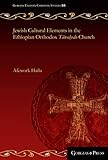Jewish Cultural Elements in the Ethiopian Orthodox Täwaḥədo Church : - / Afework Hailu.
Material type: TextSeries: Gorgias Eastern Christian Studies ; 55Publisher: Piscataway, NJ : Gorgias Press, [2020]Copyright date: ©2019Description: 1 online resource (369 p.)Content type:
TextSeries: Gorgias Eastern Christian Studies ; 55Publisher: Piscataway, NJ : Gorgias Press, [2020]Copyright date: ©2019Description: 1 online resource (369 p.)Content type: - 9781463207175
- 9781463241308
- 281/.75 23
- BX143.3
- BX143.3
- online - DeGruyter
- Issued also in print.
| Item type | Current library | Call number | URL | Status | Notes | Barcode | |
|---|---|---|---|---|---|---|---|
 eBook
eBook
|
Biblioteca "Angelicum" Pont. Univ. S.Tommaso d'Aquino Nuvola online | online - DeGruyter (Browse shelf(Opens below)) | Online access | Not for loan (Accesso limitato) | Accesso per gli utenti autorizzati / Access for authorized users | (dgr)9781463241308 |
Frontmatter -- TABLE OF CONTENTS -- ACKNOWLEDGMENTS -- ACRONYMS AND ABBREVIATIONS -- TRANSLITERATION -- INTRODUCTION -- PART I. STUDIES ON THE 'JUDAIC HERITAGE' OF THE ETHIOPIAN CHURCH -- CHAPTER 1. 'JEWISH' AND 'JUDAIC' ELEMENTS IN ETHIOPIA -- CHAPTER 2. THE 'JUDAIC' IDENTITY OF AKSUM: JEWISH IMPACT PRIOR TO THE FOURTH CENTURY CE? -- PART II. 'JUDAIC' REVERBERATIONS IN THE ANCIENT ETHIOPIAN CHURCH -- CHAPTER 3. AKSUM AND THE INTRODUCTION OF CHRISTIANITY: 'JEWISH' AND 'OLD TESTAMENT' HERITAGES -- CHAPTER 4. FROM THE BIBLE IN AKSUM TO THE 'TABOT' ('ARK') IN LALIBELA: TRACING 'ISRAELITE' ETHOS AND 'JUDAIC' CULTURAL DEVELOPMENT IN THE 6TH CENTURY CE -- PART III. 'SOLOMONIC' IDENTITY AND 'JUDAIC' ELEMENTS IN THE ETHIOPIAN CHURCH -- CHAPTER 5: FROM ክብረነገሥት(KƎBRÄ NÄGÄŚT) TO መጽሐፈብርሃን (MÄṢḤAFÄ BƎRHAN): THRIVING 'JUDAIC' IDENTITY IN THE ETHIOPIAN CHURCH -- CHAPTER 6: ATTEMPTS TO DELINEATE THE POSITION OF THE CHURCH ON 'JUDAIC' CULTURAL PRACTICES AND CONCOMITANT IMPACT -- CONCLUSION -- BIBLIOGRAPHY -- APPENDICES -- INDEX OF AUTHORS -- INDEX OF SUBJECTS AND PERSONS
restricted access online access with authorization star
http://purl.org/coar/access_right/c_16ec
This book investigates the formation of the Jewish cultural profile of the Ethiopian Orthodox Täwaḥədo Church (EOTC), arguing that it was formed after the sixth century CE through gradual and complex socio-politico-cultural processes, which spanned many centuries. To this end, it employs historical and literary evidence to (re)examine the religious profile of the pre- and post- fourth century CE Aksumite kingdom, and probes the robust cultural developments of the empire in the sixth century in order to highlight the existence of a 'Jewish/Judaeo-Christian' identity. Aksum's relationship with Jews across the Red Sea and its potential impact on the later development of Ethiopia's Jewish culture is examined, particularly during the Zagʷe era, for which scant but important historical evidence is provided. Afework demonstrates that the impact of indigenous culture, coupled with the steady growth of a 'Judaic' heritage of the church, beginning in the sixth century, was accompanied by the emergence of an 'Israelite' and 'Solomonic' ethos. The translation of some of the works of 'Church Fathers' in and after the fourteenth century further augmented this impact. The Jewish cultural heritage, particularly, was fully developed and shaped during the fifteenth and sixteenth centuries, as is epitomised by the series of debates about the place of Sabbath and the further theologising and contextualising efforts regarding the 'Judaic' elements of the EOTC.
Issued also in print.
Mode of access: Internet via World Wide Web.
In English.
Description based on online resource; title from PDF title page (publisher's Web site, viewed 31. Jan 2022)


